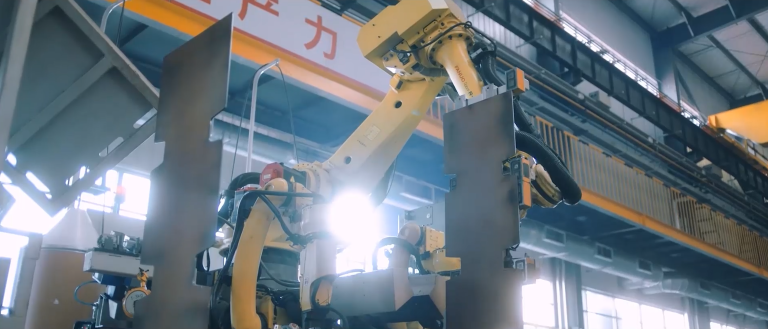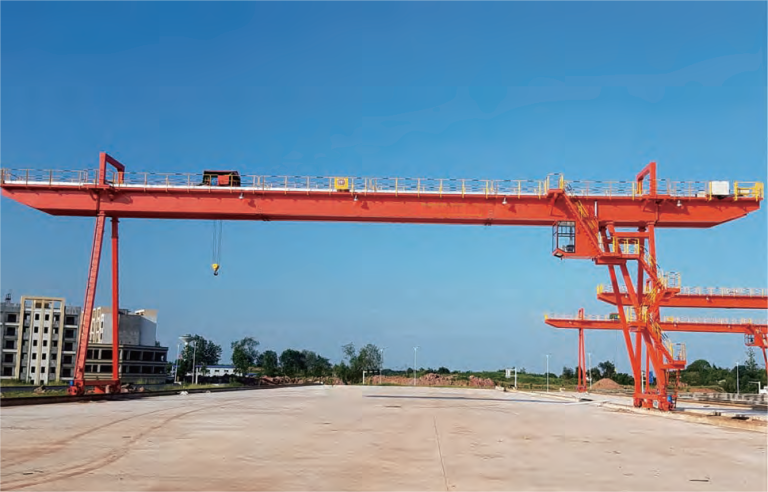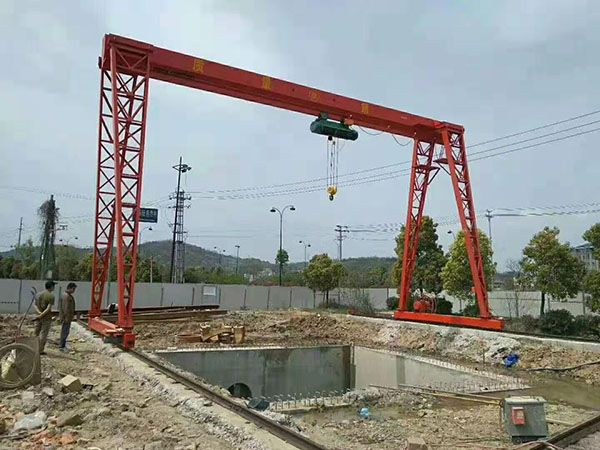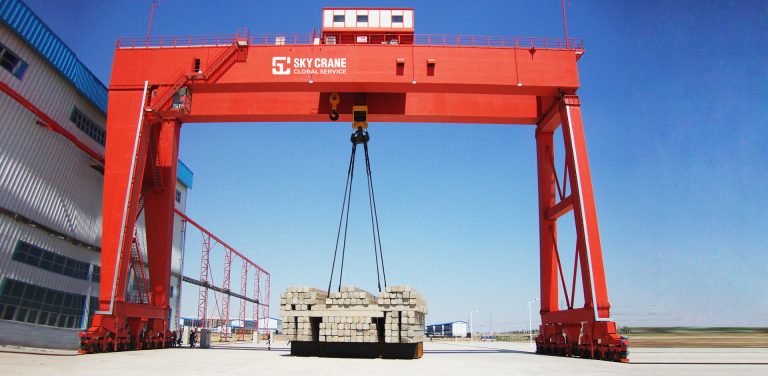Table of Contents
Helu Serial
inoa
| LD uila hoʻokahi pahu pahu pahu | Semi – gantry Crane |
| 1 | ʻano crane ʻEulopa |
| 2 | Ma waho aʻe o kā lākou hoʻolālā paʻa, hiki ke hoʻololi ʻia nā cranes gantry hoʻokahi. Hiki ke hoʻohālikelike ʻia lākou e hoʻokō i nā pono kikoʻī o ka noi, inā paha e hāpai ana i nā mīkini kaumaha i loko o kahi hale hana hana a i ʻole ka hoʻouka ʻana a me ka wehe ʻana i nā pahu i loko o kahi hale kūʻai. Hiki i kēia maʻalahi ke hoʻonui i ka pono a me ka hoʻonui ʻana i ka hana.
ʻO kekahi mea maikaʻi o nā cranes gantry beam hoʻokahi ko lākou kumukūʻai. Ke hoʻohālikelike ʻia me nā ʻano cranes ʻē aʻe, e like me nā cranes double beam gantry a i ʻole overhead cranes, ʻoi aku ka maʻalahi o nā cranes gantry beam hoʻokahi ke kūʻai a mālama. He koho kūpono kēia no nā ʻoihana e ʻimi ana e hoʻonui i kā lākou kālā me ka ʻole o ka ʻai ʻana i ka maikaʻi a i ʻole ka hana. Eia kekahi, ua ʻike ʻia nā cranes gantry hoʻokahi no ka lōʻihi a me ka hilinaʻi. Kūkulu ʻia kēia mau cranes e pale aku i nā ukana kaumaha a me nā kūlana hana paʻakikī, e hoʻolilo iā lākou i koho hilinaʻi no ka hoʻohana ʻana i ka ʻoihana. Me ka mālama pono ʻana a me ka mālama pono, hiki i nā cranes gantry beam hoʻokahi ke hoʻomau no nā makahiki he nui, e hāʻawi ana i kahi hopena lōʻihi no ka hāpai ʻana a me ka hoʻoneʻe ʻana i nā mea kaumaha. Ma waho aʻe o ko lākou lōʻihi, maʻalahi hoʻi ka hana ʻana i nā cranes gantry hoʻokahi. Hiki iā lākou ke hoʻomalu mamao a lima paha, e ʻae ana i nā neʻe pololei a me ke kūlana o ka ukana. ʻO kēia ka mea i koho palekana a maikaʻi hoʻi no ka hāpai ʻana a me ka lawe ʻana i nā mea kaumaha ma ka wahi hana. |
| 3 | Nā hiʻohiʻona koʻikoʻi e ʻimi ai i ka wā e koho ai i kahi ʻauʻau Gantry Beam hoʻokahi |
| 4 | Ke koho ʻana i kahi crane gantry beam hoʻokahi, aia kekahi mau hiʻohiʻona nui āu e noʻonoʻo ai e hōʻoia i ka loaʻa ʻana o ka crane maikaʻi loa no kāu mau pono. Hoʻohana maʻamau ʻia nā pahu gantry beam hoʻokahi i nā ʻoihana like ʻole no ka hāpai ʻana a me ka hoʻoneʻe ʻana i nā ukana kaumaha, no laila he mea nui ke koho ʻana i kahi crane i hilinaʻi, kūpono, a palekana hoʻi e hoʻohana.
Kekahi o nā hiʻohiʻona nui e nānā i ke koho ʻana i kahi ʻO ka puʻu gantry beam hoʻokahi ka hiki ke hāpai. ʻO ka hiki ke hāpai ʻia o kahi crane e pili ana i ke kaumaha kiʻekiʻe loa e hiki ke hāpai me ka palekana. He mea koʻikoʻi ke koho ʻana i kahi crane me ka hiki ke hāpai i kūpono i nā ukana āu e hāpai mau ai. ʻO ke koho ʻana i kahi crane me ka ʻoi aku o ka hiki ke hāpai ʻia ma mua o kou pono hiki ke alakaʻi i nā kumukūʻai pono ʻole, ʻoiai ke koho ʻana i kahi crane me ka haʻahaʻa haʻahaʻa hiki ke hoʻololi i ka palekana a me ka pono. . ʻO ka lōʻihi o ka crane e pili ana i ka mamao ma waena o nā wāwae ʻelua o ka crane. Pono ka lōʻihi o ka crane no ka wahi i loaʻa i kāu keʻena a me ka nui o nā ukana āu e hāpai ai. He mea nui e koho i ka crane me ka loa span e hiki ai ke maalahi i ka hana a me ka hana pono. ʻO ke kiʻekiʻe hoʻokiʻekiʻe o kahi crane e pili ana i ke kiʻekiʻe kiʻekiʻe e hiki ai i ka crane ke hāpai i kahi ukana. He mea nui e koho i kahi crane me kahi kiʻekiʻe hoʻi i kūpono i ke kiʻekiʻe o kāu hale hana a me ke kiʻekiʻe o nā ukana āu e hāpai ai. ʻO ke koho ʻana i kahi puʻu me kahi kiʻekiʻe haʻahaʻa haʻahaʻa hiki ke kaupalena i ke ʻano o nā ukana hiki iā ʻoe ke hāpai, ʻoiai ke koho ʻana i kahi puʻu me kahi kiʻekiʻe hoʻokiʻekiʻe kiʻekiʻe hiki ke alakaʻi i nā kumukūʻai pono ʻole. He mea koʻikoʻi nō hoʻi ka wikiwiki hāpai. e noʻonoʻo i ke koho ʻana i kahi pahu gantry crane. ʻO ka māmā holo o ka crane e pili ana i ka wikiwiki e hiki ai i ka crane ke hāpai a hoʻohaʻahaʻa i kahi ukana. He mea nui e koho i kahi crane me ka wikiwiki hāpai i kūpono no ka pono o kāu mau hana. ʻO ke koho ʻana i kahi puʻu me ka māmā haʻi haʻahaʻa hiki ke alakaʻi i ka lohi i ka hana ʻana, ʻoiai ke koho ʻana i kahi crane me ka wikiwiki hāpai wikiwiki hiki ke hoʻonui i ka huahana. crane gantry. ʻO nā hiʻohiʻona palekana e like me ka pale ʻana i ka ukana, nā pihi hoʻomaha pilikia, a me nā hoʻololi palena he mea nui ia no ka hōʻoia ʻana i ka palekana o nā mea hana a me ka pale ʻana i nā pōʻino. He mea nui e koho i ka crane i lako me na mea e pono ai ka palekana no ka pale ana i na limahana a me na lako. I ka hopena, i ke koho ana i hookahi beam gantry crane, he mea nui e noonoo i na mea nui e like me ka hiki ke hapai, ka loa span, ke kiʻekiʻe hoʻokiʻekiʻe, ka wikiwiki hāpai, a me nā hiʻohiʻona palekana. Ma ka loiloi pono ʻana i kēia mau hiʻohiʻona, hiki iā ʻoe ke hōʻoia i ke koho ʻana i kahi crane i hilinaʻi, kūpono, a palekana hoʻi e hoʻohana. E koho i kahi mea hoʻolako Kina kaulana no ka crane gantry beam maikaʻi loa i kūpono i kāu mau pono kikoʻī. |
Pehea e mālama pono ai a hoʻolōʻihi i ke ola o kahi ʻauʻau Gantry Beam hoʻokahi
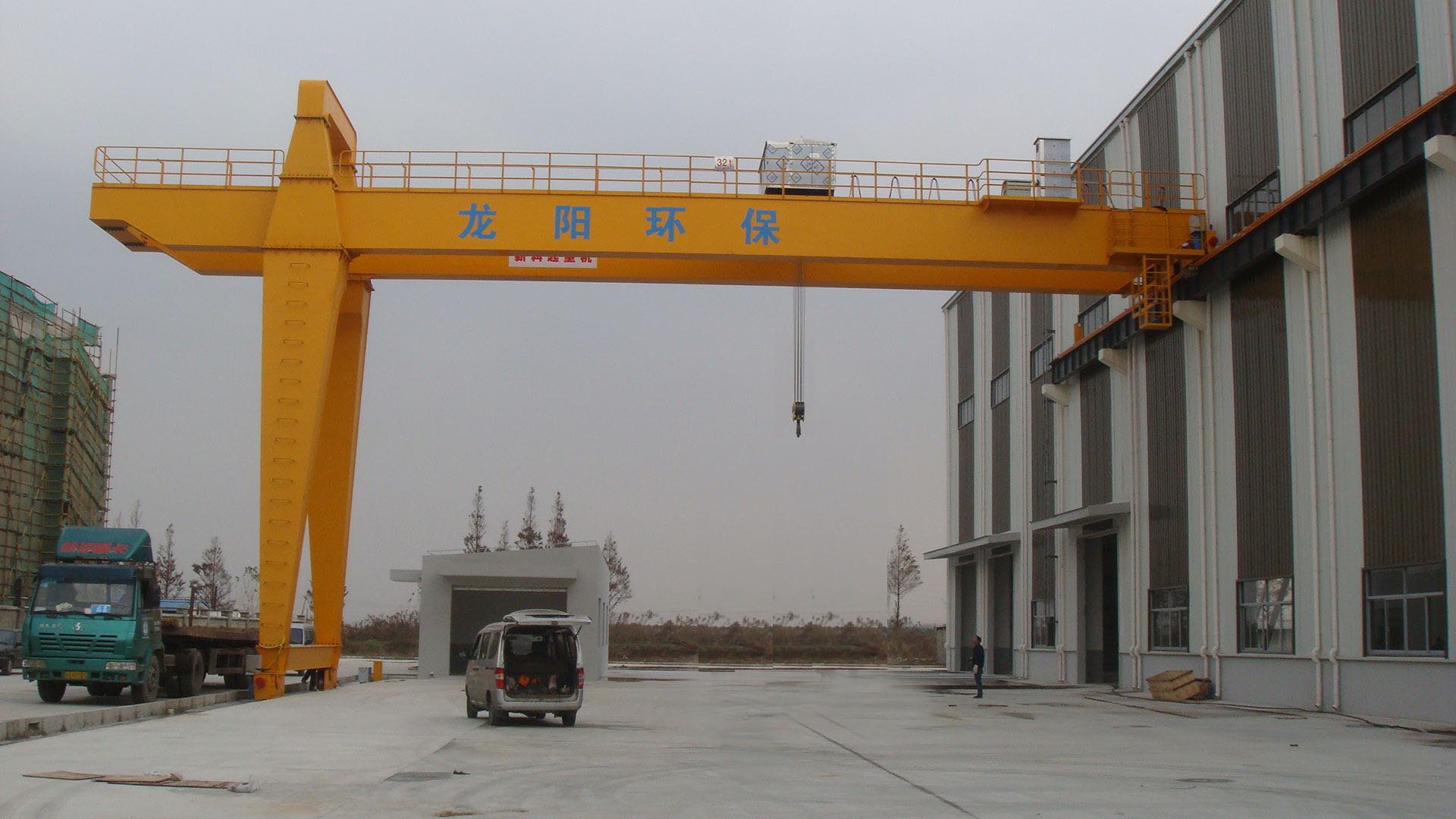
He mau ʻāpana koʻikoʻi o nā ʻano hana like ʻole, me ke kūkulu ʻana, ka hana ʻana, a me ka logistic. Hoʻohana ʻia kēia mau cranes e hāpai a hoʻoneʻe i nā ukana kaumaha me ka pololei a me ka pono. No ka hōʻoiaʻiʻo ʻana i ka hana maʻemaʻe o kahi crane gantry beam hoʻokahi a hoʻonui i kona ola, he mea koʻikoʻi ka mālama pono ʻana.
E nānā i ka crane no nā hōʻailona o ka ʻaʻahu a me ka weluwelu, e like me nā bolts hemo, nā uwea kahiko, a i ʻole nā ʻāpana ʻino. E noʻonoʻo pono i ka mīkini hoʻokiʻekiʻe, no ka mea ma laila ka nui o nā pilikia. E nānā i nā walaʻau like ʻole, nā haʻalulu, a i ʻole nā kahe e hōʻike ana i kahi pilikia.
Ma waho aʻe o ka nānā mau ʻana, pono e hahai i kahi papa hana mālama i ʻōlelo ʻia e ka mea hana. Pono e hoʻokomo i kēia papahana i nā hana maʻamau e like me ka lubricating o nā ʻāpana neʻe, ka nānā ʻana i nā pae wai, a me ka hoʻopaʻa ʻana i nā bolts. E mālama i kahi moʻolelo kikoʻī o nā hana mālama a pau, me ka lā, ka manawa, a me ke ʻano o ka hana i hana ʻia. E kōkua kēia iā ʻoe e nānā i ka hana a ka crane i ka manawa a me ka ʻike ʻana i nā ʻano like ʻole a i ʻole nā hiʻohiʻona e pono ai ke nānā. E mālama i ka crane ma kahi maʻemaʻe, maloʻo, a me ka makani maikaʻi e pale ai i ka pala a me ka ʻino. E mālama i ka crane i uhi ʻia ke hoʻohana ʻole ʻia e pale aku i ka lepo, nā ʻōpala, a me nā mea haumia ʻē aʻe. Inā ʻike ʻia ka crane i nā kūlana ʻino, e noʻonoʻo e hoʻokomo i kahi uhi pale a i ʻole kahi hale e pale ai iā ia mai nā kumu.
E hoʻomaʻemaʻe mau i ka crane no ka wehe ʻana i ka lepo, ka momona, a me nā ʻōpala ʻē aʻe e hiki ke hōʻiliʻili ma luna o kona mau ʻili. E hoʻohana i ka mea holoi maʻemaʻe a me ka wai e hoʻomaʻemaʻe i ka crane, e mālama pono e pale aku i ka hoʻohana ʻana i nā mea hoʻomaʻemaʻe abrasive a i ʻole nā solvents e hiki ke hōʻino i ka pena a i ʻole ka pau ʻana. E nānā i ka crane no nā hōʻailona o ka ʻōpala a ʻino paha, a e hoʻoponopono koke i kēia mau pilikia i mea e pale aku ai i ka pōʻino. E hōʻoia i ka hoʻomaʻamaʻa pono ʻana a me ka hōʻoia ʻana o nā mea hana a pau e hana i ka crane, a hāʻawi i ka hoʻomaʻamaʻa mau ʻana e hoʻomau i ko lākou mau mākaukau. Hoʻoikaika i ka pono o ka hahai ʻana i nā kuʻina palekana a me nā kaʻina hana no ka pale ʻana i nā pōʻino a me nā pōʻino.
ʻO ka hoʻopukapuka ʻana i nā ʻāpana a me nā ʻāpana kiʻekiʻe kahi ʻano koʻikoʻi o ka mālama ʻana i kahi crane gantry beam hoʻokahi. E hoʻohana i nā ʻāpana maoli mai kahi mea hoʻolako kaulana e hōʻoia i ka hoʻohālikelike a me ka hana. E hōʻalo i ka hoʻohana ʻana i nā ʻāpana haʻahaʻa a haʻahaʻa paha i hiki ke hoʻopilikia i ka palekana a me ka hilinaʻi o ka crane. E hoʻololi mau i nā ʻāpana ʻinoʻino a i ʻole nā ʻāpana ʻino i mea e pale ai i ka pōʻino hou aʻe a e hōʻoia i ka hoʻomau ʻana o ka hana o ka crane.
I ka hopena, pono ka mālama pono ʻana no ka hoʻolōʻihi ʻana i ke ola o kahi pahu gantry crane. Ma ka hahai ʻana i ka papa hana mālama mau, ka nānā pono ʻana, mālama pono i ka crane, hoʻomaʻemaʻe maʻamau, hoʻomaʻamaʻa i nā mea hana, a me ka hoʻohana ʻana i nā ʻāpana pani kiʻekiʻe, hiki iā ʻoe ke hōʻoia i ka hana palekana a me ka maikaʻi o ka crane no nā makahiki e hiki mai ana. E hoʻomanaʻo ʻoi aku ka maikaʻi o ka pale ʻana ma mua o ka mālama ʻana i ka mālama ʻana i kāu crane gantry beam.
Key Features to Look for When Choosing a Single Beam Gantry Crane
When it comes to choosing a single beam gantry crane, there are several key features that you should consider to ensure that you are getting the best quality crane for your needs. Single beam gantry cranes are commonly used in various industries for lifting and moving heavy loads, so it is important to choose a crane that is reliable, efficient, and safe to use.
One of the most important features to look for when choosing a single beam gantry crane is the lifting capacity. The lifting capacity of a crane refers to the maximum weight that it can lift safely. It is crucial to choose a crane with a lifting capacity that is suitable for the loads that you will be lifting on a regular basis. Choosing a crane with a higher lifting capacity than you need can lead to unnecessary costs, while choosing a crane with a lower lifting capacity can compromise safety and efficiency.
Another key feature to consider when choosing a single beam gantry crane is the span length. The span length of a crane refers to the distance between the two legs of the crane. The span length of the crane should be suitable for the space available in your facility and the size of the loads that you will be lifting. It is important to choose a crane with a span length that allows for easy maneuverability and efficient operation.
The hoisting height is another important feature to consider when choosing a single beam gantry crane. The hoisting height of a crane refers to the maximum height that the crane can lift a load. It is important to choose a crane with a hoisting height that is suitable for the height of your facility and the height of the loads that you will be lifting. Choosing a crane with a hoisting height that is too low can limit the types of loads that you can lift, while choosing a crane with a hoisting height that is too high can lead to unnecessary costs.
The lifting speed is also an important feature to consider when choosing a single beam gantry crane. The lifting speed of a crane refers to the speed at which the crane can lift and lower a load. It is important to choose a crane with a lifting speed that is suitable for the efficiency of your operations. Choosing a crane with a slow lifting speed can lead to delays in production, while choosing a crane with a fast lifting speed can improve productivity.
In addition to these key features, it is also important to consider the safety features of a single beam gantry crane. Safety features such as overload protection, emergency stop buttons, and limit switches are essential for ensuring the safety of operators and preventing accidents. It is important to choose a crane that is equipped with the necessary safety features to protect both workers and equipment.
In conclusion, when choosing a single beam gantry crane, it is important to consider key features such as lifting capacity, span length, hoisting height, lifting speed, and safety features. By carefully evaluating these features, you can ensure that you are choosing a crane that is reliable, efficient, and safe to use. Choose a reputable Chinese supplier for the best quality single beam gantry crane that meets your specific needs.
How to Properly Maintain and Extend the Lifespan of a Single Beam Gantry Crane
Single beam gantry cranes are essential pieces of equipment in various industries, including construction, manufacturing, and logistics. These cranes are used to lift and move heavy loads with precision and efficiency. To ensure the smooth operation of a single beam gantry crane and extend its lifespan, proper maintenance is crucial.
Regular inspections are key to identifying any potential issues before they escalate into major problems. Inspect the crane for signs of wear and tear, such as loose bolts, worn-out cables, or damaged components. Pay close attention to the hoisting mechanism, as this is where most problems tend to occur. Check for any unusual noises, vibrations, or leaks that could indicate a problem.
In addition to regular inspections, it is important to follow a maintenance schedule recommended by the manufacturer. This schedule should include routine tasks such as lubricating moving parts, checking fluid levels, and tightening loose bolts. Keep a detailed record of all maintenance activities, including the date, time, and nature of the work performed. This will help you track the crane’s performance over time and identify any patterns or trends that may require attention.
Proper storage is also essential for maintaining a single beam gantry crane. Store the crane in a clean, dry, and well-ventilated area to prevent rust and corrosion. Keep the crane covered when not in use to protect it from dust, debris, and other contaminants. If the crane is exposed to harsh weather conditions, consider installing a protective cover or shelter to shield it from the elements.
Regularly clean the crane to remove dirt, grease, and other debris that can accumulate on its surfaces. Use a mild detergent and water to clean the crane, taking care to avoid using abrasive cleaners or solvents that could damage the paint or finish. Inspect the crane for any signs of rust or corrosion, and address these issues promptly to prevent further damage.
Properly maintaining a single beam gantry crane also involves training and educating operators on safe and efficient operation. Ensure that all operators are properly trained and certified to operate the crane, and provide ongoing training to keep their skills up to date. Emphasize the importance of following safety protocols and procedures to prevent accidents and injuries.
Investing in high-quality replacement parts and components is another key aspect of maintaining a single beam gantry crane. Use genuine parts from a reputable supplier to ensure compatibility and performance. Avoid using cheap or inferior parts that could compromise the crane’s safety and reliability. Regularly replace worn-out or damaged parts to prevent further damage and ensure the crane’s continued operation.
In conclusion, proper maintenance is essential for extending the lifespan of a single beam gantry crane. By following a regular maintenance schedule, conducting thorough inspections, storing the crane properly, cleaning it regularly, training operators, and using high-quality replacement parts, you can ensure the crane’s safe and efficient operation for years to come. Remember that prevention is always better than cure when it comes to maintaining your single beam gantry crane.



